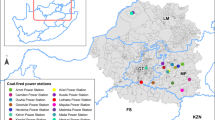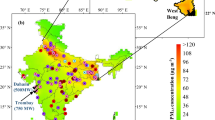Abstract
At the centre of all air quality regulation stands the right of humans to an environment that is not harmful to health and well-being. In many developing countries, including South Africa, coal-fired power station emissions are managed both from an ambient air quality and minimum emissions standpoint. Ambient air quality standards and minimum emissions standards (MES) are often in conflict with one another, as power stations in which vicinity ambient air quality standards are met still have to comply with a blanket set of MES. In developing countries this often leads to the unnecessary incurrence of already constrained financial resources. This study proposes an alternative emissions management strategy where potential human health exposure is used as a decision-making basis on which power station emissions control is founded. The potential human health exposure of population groups to primary particulate matter with a diameter of 10 μm or less (PM10), secondary sulphurous and nitrous particulate matter (PM), sulphur dioxide (SO2) and oxides of nitrogen (NOx) emissions are calculated and compared for 13 power stations in the highveld of South Africa. It was found that the potential human health exposure to individual power stations differ substantially. It is suggested that it makes more sense both from both a human health and fiscal perspective that emissions from coal-fired power stations be managed on an individual power station basis, especially in developing countries.










Similar content being viewed by others
References
Bennet, DH., McKone, T.E., Evans, J.S., Nazaroff, W.W., Margni, M.D., Jolliet, O.J. and K.R. Smith, 2002. Defining intake fraction. Environmental Science & Technology, 207 A
Department of Environmental Affairs, 2011. The Highveld Priority Area Air Quality Management Plan, Draft. Pretoria, South Africa
Department of Environmental Affairs and Tourism (2007) Declaration of the highveld as priority area in terms of section 18(1) of the National Environmental: Air Quality Act, 2004 (Act No. 39 of 2004). Government Notice, No. 30518
Emery C, Tai E, Yarwood G (2001) Enhanced meteorological modelling and performance evaluation for two Texas ozone episodes. Report to the Texas Natural Resources Conservation Commission, prepared by ENVIRON. International Corp, Novato
Evans JS, Wolff SK, Phonboon K, Levy JI, Smith KR (2002) Exposure efficiency: an idea whose time has come? Chemosphere 49:1075–1091
Exponent Inc (2014) Review of the Sasol Atmospheric Impact Report. Exponent Inc, Mynard
Hao JM, Li J, Ye XM, Zhu TL (2003) Estimating health damage cost from secondary sulfate particles—a case study of Hunan Province. China J Environ Sci China 15:611–617
Hao J, Wang L, Shen M, Li L, Hu J (2007) Air quality impacts of power plant emissions in Beijing. Environ Pollu 147:401–408
Kumar A, Luo J, Bennet G (1993) Statistical evaluation of lower flammability distance (LFD) using four hazardous release models. Process Saf Prog 12(1):1–11
Levy JI, Spengler JD, Hlinka D, Sullivan D, Moon D (2002) Using CALPUFF to evaluate the impacts of power plant emissions in Illinois: model sensitivity and implications. Atmos Environ 36:1063–1075
Levy JI, Wilson AM, Evans JS, Spengler JD (2003) Estimation of primary and secondary particulate matter intake fractions for power plants in Georgia. Environ Sci Technol 37:5528–5536
Li J, Hao JM (2003) Application of intake fraction to population exposure estimates in Hunan Province of China. J Environ Sci Health Part A-Toxic/Hazard Subst Environ Eng 38:1041–1054
Lu Y, Fang TB (2015) Examining personal air pollution exposure, intake, and health danger zone using time geography and 3D geovisualization. Int J Geo-Inf 4:32–46
Smith KR (1993) Fuel combustion, air pollution exposure, and health: the situation in developing countries. Annu Rev Energy Environ 18:529–566
Statistics South Africa (2012) Census 2011 statistical release—P0301.4/Statistics South Africa. Statistics South Africa, Pretoria
Tesche TW, McNally DE, Tremback C (2002) Operational evaluation of the MM5 meteorological model over the continental United States: protocol for annual and episodic evaluation. Prepared for the Office of Air Quality Planning and Standards U.S. Environmental Protection Agency Research Triangle Park, NC
Tesche TW, McNally DE, Emery CA, Tai E (2001) Evaluation of the MM5 Model over the Midwestern U.S. for Three 8-Hr Oxidant Episodes”, prepared for the Kansas City Ozone Technical Work Group, prepared by Alpine Geophysics, LLC, Ft
United States Environmental Protection Agency AP42 (1994) A revised user guide to MESOPUFF II. Research Triangle Park, North Carolina
US Environmental Protection Agency (1998) Interagency Workgroup on Air Quality Modelling (IWAQM) phase 2 summary report and recommendations for modelling long range transport impacts
Wolff SK (2000) Evaluation of fine particle exposures, health risks and control options. Doctoral thesis, Harvard School of Public Health
Zhou Y, Levy JI, Hammitt JK, Evans JS (2003) Estimating population exposure to power plant emissions using CALPUFF: a case study in Beijing. China Atmos Environ 37:815–826
Zhou Y, Levy JI, Evans JS, Hammitt JK (2006) The influence of geographic location on population exposure to emissions from power plants throughout China. Environ Int 32:365–373
Author information
Authors and Affiliations
Corresponding author
Rights and permissions
About this article
Cite this article
Pretorius, I., Piketh, S. & Burger, R. Emissions management and health exposure: should all power stations be treated equal?. Air Qual Atmos Health 10, 509–520 (2017). https://doi.org/10.1007/s11869-016-0444-x
Received:
Accepted:
Published:
Issue Date:
DOI: https://doi.org/10.1007/s11869-016-0444-x




